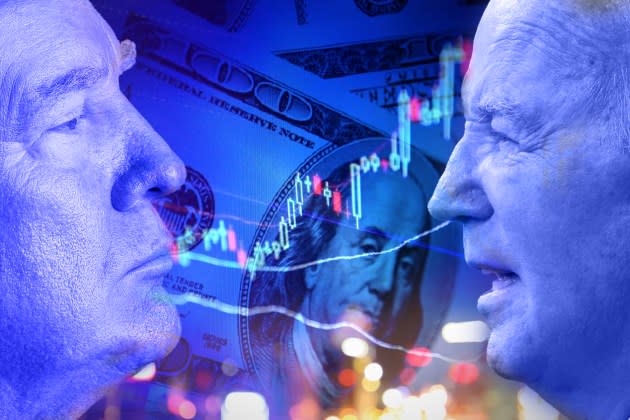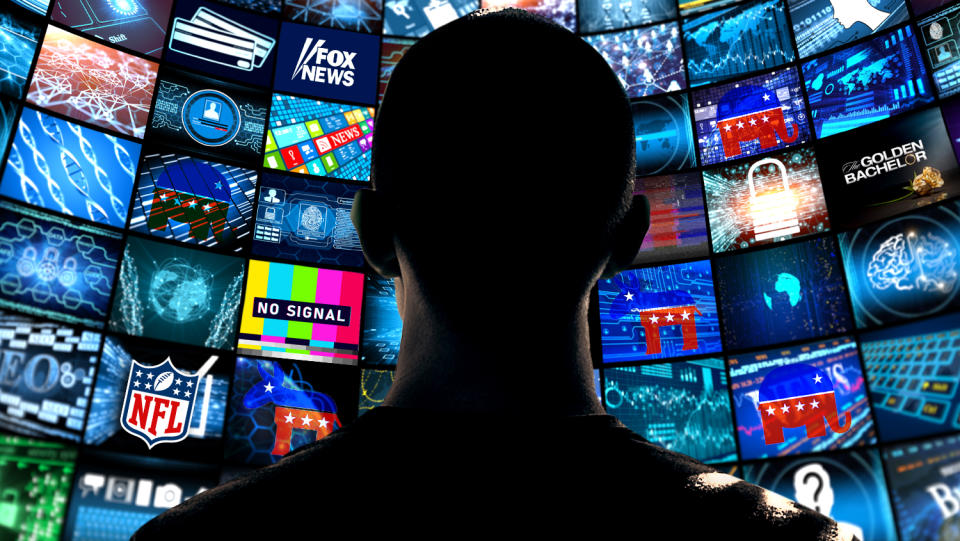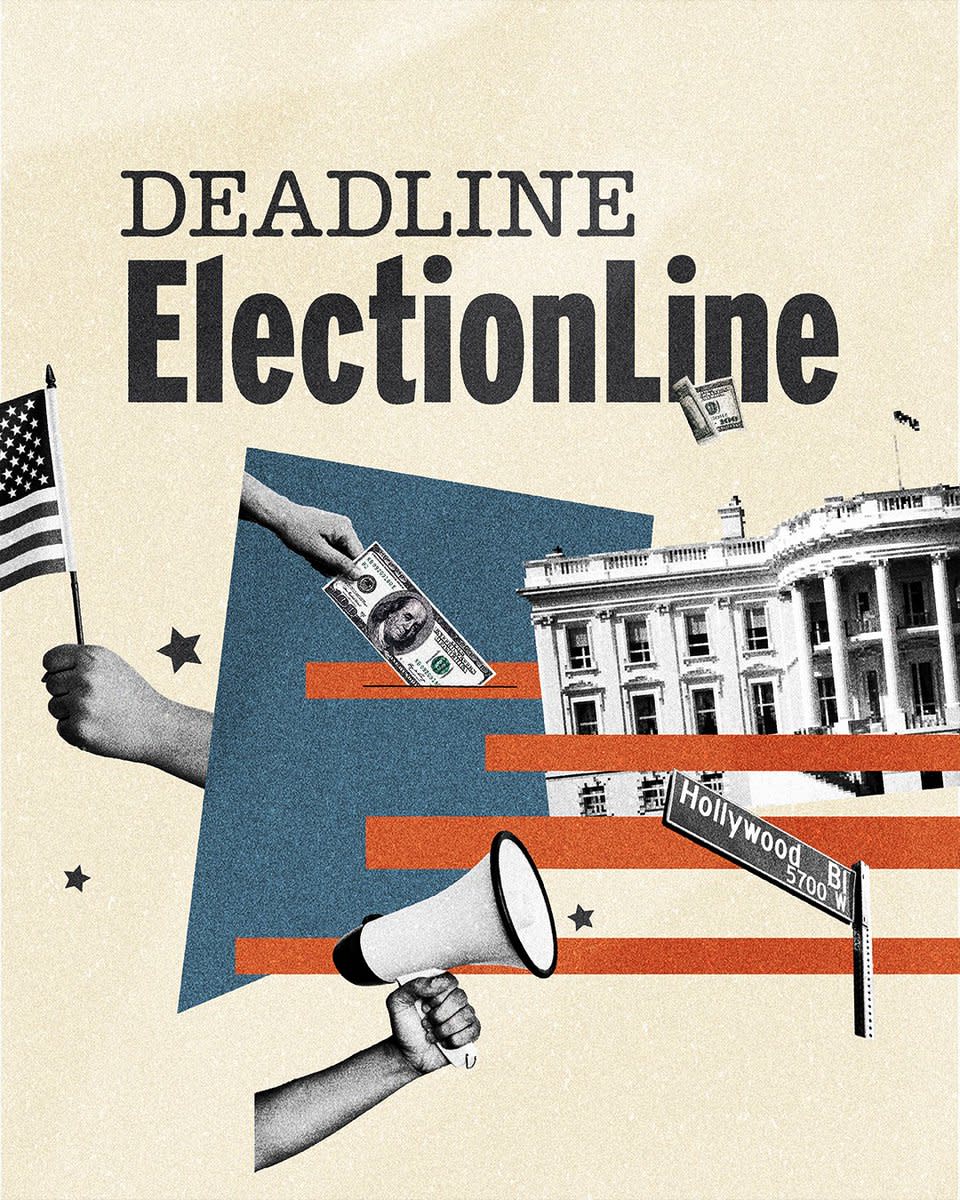Will 2024 Election Save TV? Political Ad Spend For Joe Biden-Donald Trump Rematch Will Likely Find Broadcast & Cable Swimming In Cash
- Oops!Something went wrong.Please try again later.
- Oops!Something went wrong.Please try again later.

If current polls are to be believed, American voters are looking with a sense of dread at a rematch between Joe Biden and Donald Trump. Yet, widely anticipating the most expensive election in the nation’s history, another cycle of bitter and polarized politics perversely may be exactly the bottom-line boost TV broadcasters and cable networks need.
Facing ongoing labor uncertainty as SAG-AFTRA continues to negotiate with Hollywood studios to end its 90-day strike and battered by eroding ratings, rumors of potential sales or consolidation, months of writers on the picket lines, and the perception of inevitable decline, linear TV is looking with confidence at a contentious battle for the presidency next year. That, plus lucrative campaigns for control of the Senate and the House and a bevy of state races, could result in something akin to a well-timed bailout.
More from Deadline
2024 Presidential Election Debate Schedule: Dates, Times, Who’ll Be There And Who Won’t
2024 Premiere Dates For New & Returning Series On Broadcast, Cable & Streaming
“This is going to be like the Super Bowl, but all the way to November,” a top cable news executive enthused. “Who is the demographic that votes? The over-55s. That’s our viewers, and everyone is going to pay to reach them.”
Nexstar, the largest station owner in the U.S., also talked up political spending in a recent earnings call, noting political ad spending projections of up to $11 billion for the 2024 cycle, compared with $9 billion during the 2022 midterms. Nexstar’s Tom Carter told investors the company is “highly optimistic” about growth in political advertising, and that it is “extraordinarily well positioned to take share and dollars both locally and nationally.”
That positioning is taking effect 12 months before Americans vote.
Having already trolled the two GOP presidential primary debates on Fox with ads, Biden’s reelection campaign, co-chaired by Jeffrey Katzenberg, launched a new four-month, $25 million TV ad push last week. Starting with the John Goodman-narrated “Never Left” ad emphasizing Biden’s middle-class roots, the marketing of the incumbent intends to aim at cable news and broadcast TV viewers, with a big presence during NFL games on various networks and alongside the likes of The Golden Bachelor and Dancing with the Stars.
With a Biden and Trump redux already looking likely with a little more than a year before the election, the big bucks are coming amid an otherwise soft advertising market, cratering linear ratings, an exodus to streaming, and a dearth of fresh content due to the Hollywood strikes. Coupled with hotly contested Senate campaigns in pricey markets like California, Arizona and Pennsylvania, and you have a small-screen lifeline — at least for the next year.
“Television is kind of weak in general, so with political (advertising) growing it becomes a bigger percentage of their total every cycle,” said Brian Wieser, principal at media consultancy Madison and Wall and former lead analyst at Group M.
Broadcasters are still the “most concentrated beneficiaries” in the media space. “It’s a big deal. The bottom line is they are dying for this money. They need it. The core business is extremely weak,” said another political ad player.
It’s a big deal. The bottom line is they are dying for this money. They need it. The core business is extremely weak.
political ad buyer on the 2024 election
Major broadcast groups have highlighted the potential uptick in political ad spending in their earnings calls, while individual stations have been gearing up by highlighting investments in local newscasts, the prized time for most campaigns to reach the most reliable voters.
On pace for record spend
Analytical intelligence firm AdImpact expects political ad spending to reach at least $10.2 billion this cycle across broadcast, cable, radio, satellite, digital and connected TV, or free ad supported TV channels (FAST). The Alexandria, VA-based company estimates that would be a 13% increase over the previous record: $9.02 billion during the 2019-20 cycle. Through August, as Republican wannabes attempt to topple the much-indicted Trump from snaring the GOP nomination, total spending on candidate and down-ballot campaigns has already reached $652 million — that’s 75% ahead of 2019.
In overall ad spending, broadcast is by far the biggest chunk, though its share is shrinking. Some 60% of smart TV homes have “cut the cord,” so they don’t necessarily have broadcast TV. On the flip side, many local stations have increased their streaming presence. “Candidates are never not going to want to be on their local news,” said Michele Certo of Sage Media Planning and Placement. Digital gains in political ad spend are more prevalent around cities compared with rural areas.
According to AdImpact, broadcasting is still expected to see the most spending, with $5.1 billion, or about 50%, followed by cable at $1.9 billion, or about 18%. Connected TV is expected to total $1.3 billion, or about 13%. “As voters continue to ‘cut the cord’ and shift away from traditional forms of media, reaching them regardless of consumption habits has become a main goal of advertisers,” according to AdImpact. Digital, meanwhile, is projected to reach $1.2 billion, led by Google and Facebook.
In a landscape reminiscent of 2020, the main targets on the presidential battleground map once again look to be Pennsylvania, Arizona, Georgia, Michigan, North Carolina, Nevada and Wisconsin. But contested congressional races that could shift the balance of power in D.C. find the RNC, DNC and others pouring money into those jurisdictions.
With Rep. Barbara Lee, Rep. Adam Schiff and Rep. Katie Porter competing for the California U.S. Senate seat of Diane Feinstein (after Gov. Gavin Newsom appointed Laphonza Butler to fill the vacancy after Feinstein’s death), expensive markets like L.A., San Francisco and San Diego will be awash in millions worth of political ads — both for the March primary and November’s general election. Other competitive Senate races are expected in Pennsylvania, Michigan, Montana, Wisconsin and West Virginia as Republicans try to win back control of the upper chamber. Democrats, meanwhile, will target Republicans in the 18 districts Biden won in 2020, with an aim of taking back the House.

Seven years after then-CBS chief Leslie Moonves boasted at an investor conference that Trump’s candidacy “may not be good for America, but it’s damn good for CBS,” the former president may not be the ratings driver he once was. But that doesn’t look like it will curtail the “winning,” to paraphrase the former Celebrity Apprentice host.
Station groups are pointing to the fact that Trump is facing a field of potential alternatives like Florida’s Ron DeSantis, ex-VP Mike Pence and former UN Ambassador Nikki Haley. Still, even as Trump holds a wide lead in polls, there is the prospect of a last-ditch effort by wealthy donors to try to prop up an alternative. The caveat is that this cycle’s presidential primary spending may ultimately not reach the levels of 2020, which saw late-entrant Michael Bloomberg flood the airwaves in an ill-fated effort to win the Democratic nomination. But broadcasters are still bullish about political ad revenue overall.
On a recent earnings call, Dave Lougee, the CEO of Tegna, noted that the company “has built a strategic position in key battleground states and large markets.” He said it’s expected that the 2024 presidential cycle “will break previous records.”
“First-quarter fundraising was very strong, and that’s expected to continue with a very well funded GOP presidential primary that is already active. … Add to that, the razor-thin margins in both chambers of Congress and there’s a lot at stake in the 2024 elections for both parties.”
Mike Jones, vice president of political sales at Gray Television, told Deadline that “local TV is what moves the needle. It is what makes the difference.” He noted that unlike other advertisers who may be focused on the younger, 18-49 demographic, “that is not what [campaigns] are looking for. The voters who make a difference are 35-plus.”
While digital has been growing as a piece of the political spending pie, linear “remains the top medium of choice,” even if its share has fallen. “The overall pie continues to grow,” Jones said.
Gray has five stations in Iowa, and spending there started earlier this year than in the 2020 cycle. Jones also noted that a number of their stations are in some Senate battlegrounds, including Arizona, Nevada and Ohio.
Campaigns have been investing more heavily in digital and streaming, and major media companies have made substantial investments in ensuring that they have a place as viewers habits change. Moreover, anyone watching so-called FAST channels — such as Pluto TV — are already inundated by issue ads. In the Washington, D.C. market, a PhRMA ad attacking pharmacy benefit managers airs multiple times an hour.
But despite the shift in viewer habit, “linear TV will continue to maintain its stronghold on political market share as it holds the largest amount of premium inventory and unduplicated reach opportunities,” said John Link, VP of sales for AdImpact.
In an email, Link wrote that campaigns still want the broad reach and higher viewership of linear TV, “including demographics that may not be easily accessible through digital platforms in scale.” That’s especially true for Senate and gubernatorial campaigns, “targeting a broad and mass audience.” Moreover, he wrote, advertisers and marketers can use advanced analytics to measure the impact and effectiveness of linear TV ads, including viewership and demo ratings, but “measuring these stats outside of linear TV becomes a bit more fragmented and assumptive.” Advertisers also can negotiate for premium ad slots on programs with limited clutter, and the linear ads typically allow for longer spot times than digital.
That said, Link said that they expect FAST channel ad growth given the targeting opportunities, “but a well-designed campaign will most likely lean on the strength of linear TV using other media types … as opportunities to maximize frequency” and provide access “to a more refined audience for targeting.”
Every election cycle has a new high that is largely baked in to forecasts. But as the stakes get higher, political spending keeps rising.
A factor in that is a growth in “down-ballot” spending, or ads for ballot measures and other local races. This year has abortion measures in Ohio and other states, and Wisconsin in May saw a high-profile race for state Supreme Court. According to AdImpact, the “down-ballot” spending reached $440 million, ahead of the same period in 2021 and 2019. Going into 2024, broadcast TV is projected to garner $1.4 billion from those ads alone.
FCC rules require that broadcast stations and cable systems can only charge legally qualified candidates the lowest unit charges and comparable rates for their spots. That doesn’t apply to non-candidate spots, like issue ads and those from SuperPACs, which also have been a growth area in political spending. And because stations are required to publicly disclose when a candidate makes an ad buy, it creates a sort of arms race with their rivals.
Another advantage for stations: Buyers pay cash upfront. They don’t ask for money back or makegoods if GRPs, or gross ratings points, fall short. It just comes down to election day — “Did we win or did we lose?” said Certo.
How to get “happy TV executives”
Nexstar and Gray and other independents like Scripps, Hearst, Sinclair and Scripps, as well as network owned-and-operated (O&O) station groups at Fox, CBS, NBC and ABC are set to reap hundreds of millions, in some cases political will make up half of annual revenue. The ultimate haul, however, is determined race by race, market by market. The more competitive the better. The more unexpectedly competitive, ever better.
“That’s where you get happy television executives. If you are a station owner, you are hoping that happens. You can’t plan on it. It’s out your control. You just have to make sure you have your assets in place. But that’s where you get the unexpected surprise to the upside,” said Wieser.
The bulk of spending happens in the weeks between Labor Day of next year and the elections in November, when some local stations have been known to expand their newscasts in order to accommodate the debate for placement on prized programming.
If Trump gets the nomination, it could generate a wave of anti-Trump money, not just by the Biden campaign but via a flood of Super PACs and other groups working to prevent what they see as an existential crisis for the country. One media buyer noted that Trump actually did not spend record sums last time around, and it was mostly Biden, but 2024 could be different.
Moreover, among the major streamers, Amazon, Disney+ and Netflix don’t allow political ads. But as political advertising keeps shattering records cycle after cycle, and the streamers add ad-tier plans, how long before that changes?
The FAST channel piece of the pie is expected to increase from 12% to just over 13%, according to AdImpact, amid the slightly smaller share for still-dominant broadcast TV. Certo said that as “as they age out, more people will be using streaming, and as that happens, the spending” will change.
To put it another way: Politics may be in the midst of division, tumult and discord, but when it comes to the way campaigns advertise, the change is an evolution, not a revolution.
Best of Deadline
10 Worst Fictional Presidents From Movies And TV Shows - Photo Gallery
The Best Fictional Presidents On Film And TV - Photo Gallery
2024 Presidential Election Debate Schedule: Dates, Times, Who'll Be There And Who Won't
Sign up for Deadline's Newsletter. For the latest news, follow us on Facebook, Twitter, and Instagram.


